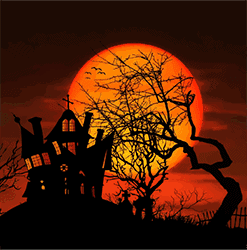Haunting Stigmas
The unknown is terrifying. Like a black abyss, waiting to produce our biggest nightmares. As humans, we seek out the familiar and avoid the mysterious to keep our lives more safe and secure. Halloween is the time of year we delve into those terrors and capitalize on adrenaline rushes. With spooky night rides, foggy corn mazes, and haunted houses, trick-or-treaters and adults alike can expect thrill after thrill.
But how far is too far? The Halloween entertainment industry – attractions, costume sales, and cinema – loves to capitalize on the belief that those with mental illnesses are unpredictable, lack morals, and are violently dangerous. If you don’t know the truths behind mental illnesses today, this ignorance-based fear can indeed be quite thrilling. Movies like Psycho (1960), Halloween (1978), The Shining (1980), Silence of the Lambs (1991), Friday the 13th (2009), and many more are considered classics of the film industry, while fostering the notion that all psychiatric disorders lead to someone chasing you with a chainsaw through a field of corn.
If you’re reading this, you already know that’s a terrible, outdated stigma and mental illness is a complex disability, not a penchant for random violence.
This time of year can be painful and saddening for those who know the difference. Amelia Joubert, a college freshman with her own history of mental illness, visited a typical Halloween attraction that included an asylum section. She told The Washington Post that “this depiction of mental hospital patients stung” and “it made me feel like I was being misrepresented.” There’s no doubt that depictions of mental illness this time of year add to the already too-prevalent stigmas that make it difficult for those with mental disabilities to maintain relationships and stay employed.
Another individual with mental illness disagreed, however: speaking to NAMI, he argued, “haunts and bizarre things are just part of the holiday fun. Everyone is reinvented via costumes. I don’t think we are singled out or stigmatized or made an object of…” There’s certainly many who would roll their eyes at our society’s growing tendency for cultural sensitivity and political correctness.
So what’s the right answer? Close attractions that feature mental disabilities and suspend the sales of straitjacket costumes? Or shrug this trend off as a harmless way to have fun?
It’s hard to say what promotes the greatest success and happiness of a whole society. One thing we know, though, is that education leads to understanding. When you find out what’s behind the curtain, the curtain itself is no longer scary; increased awareness will take away that fear and movies, music, costumes, and attractions based on old stigmas will fade away. The Halloween entertainment industry will have to devise new haunts to horrify adults – maybe future haunted houses will have a “Health Care Bills” section right after the “Taxes” maze.

